SkyDrive 2021 - London International Airport / Ontario Canada
Update: 2022/06/11 by Shawn Clish / CHK6
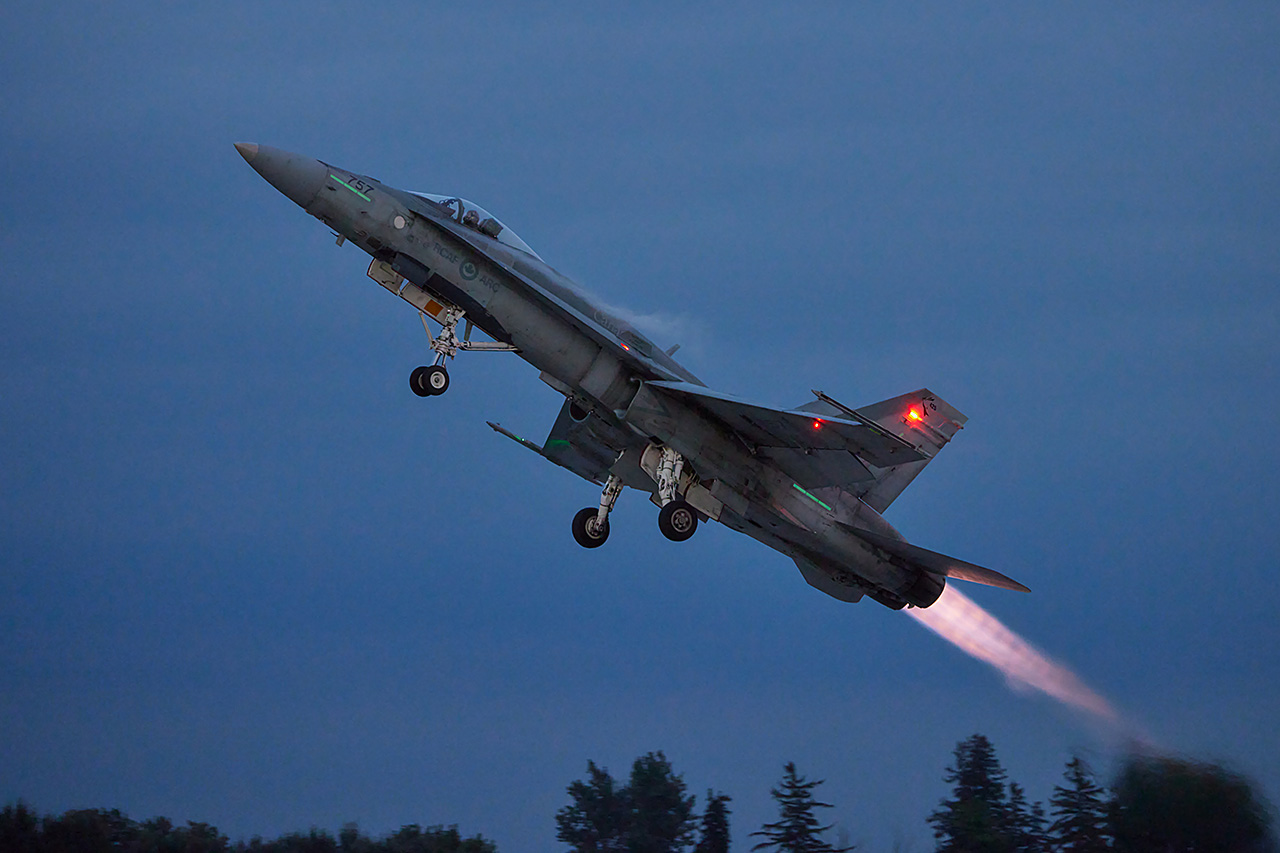
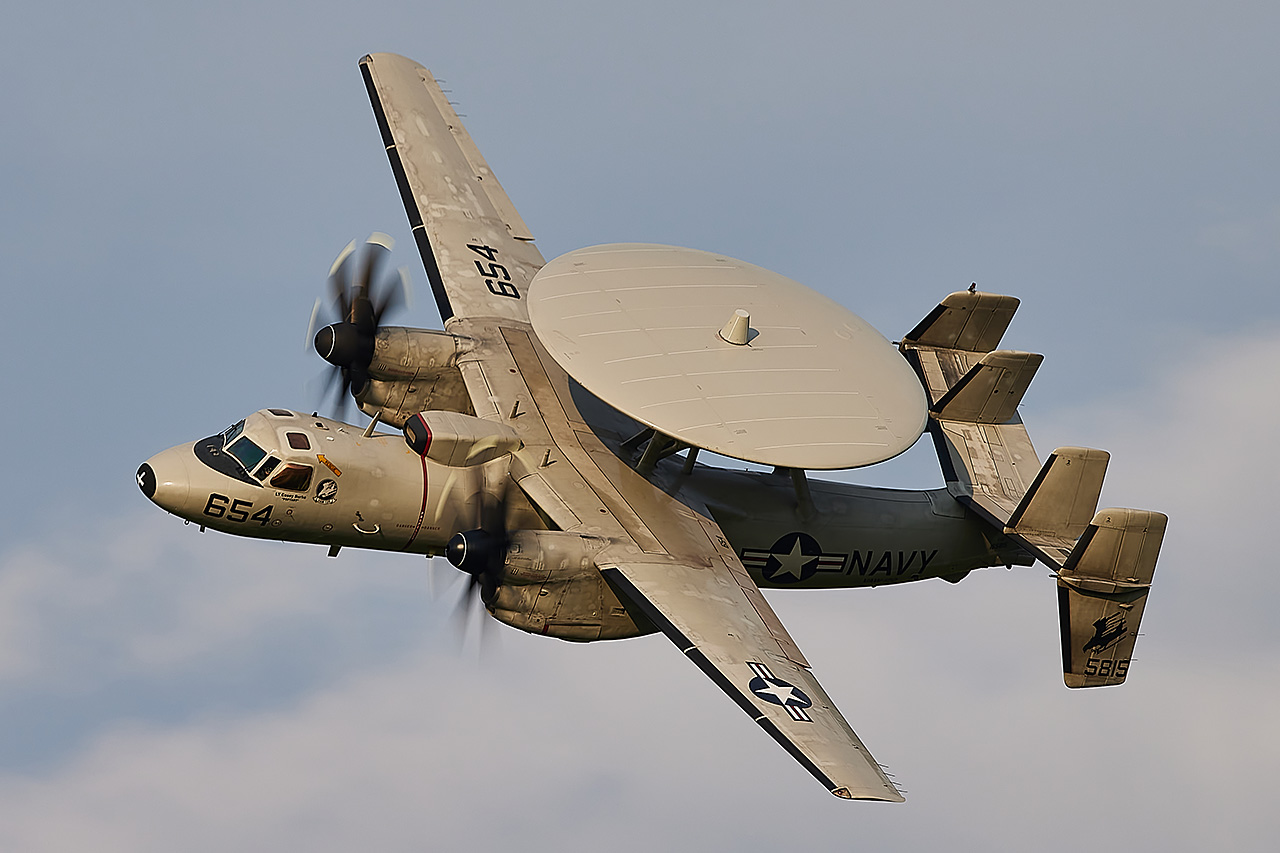
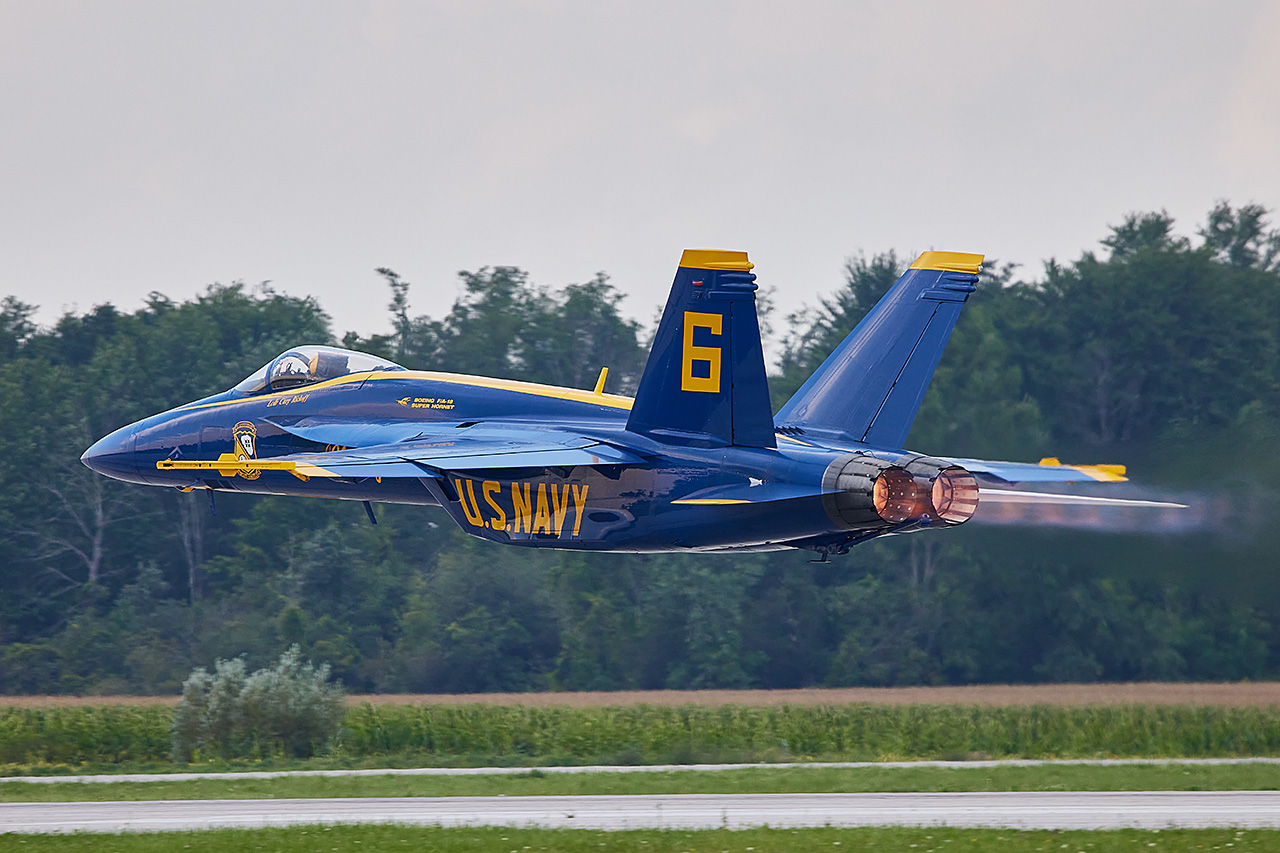
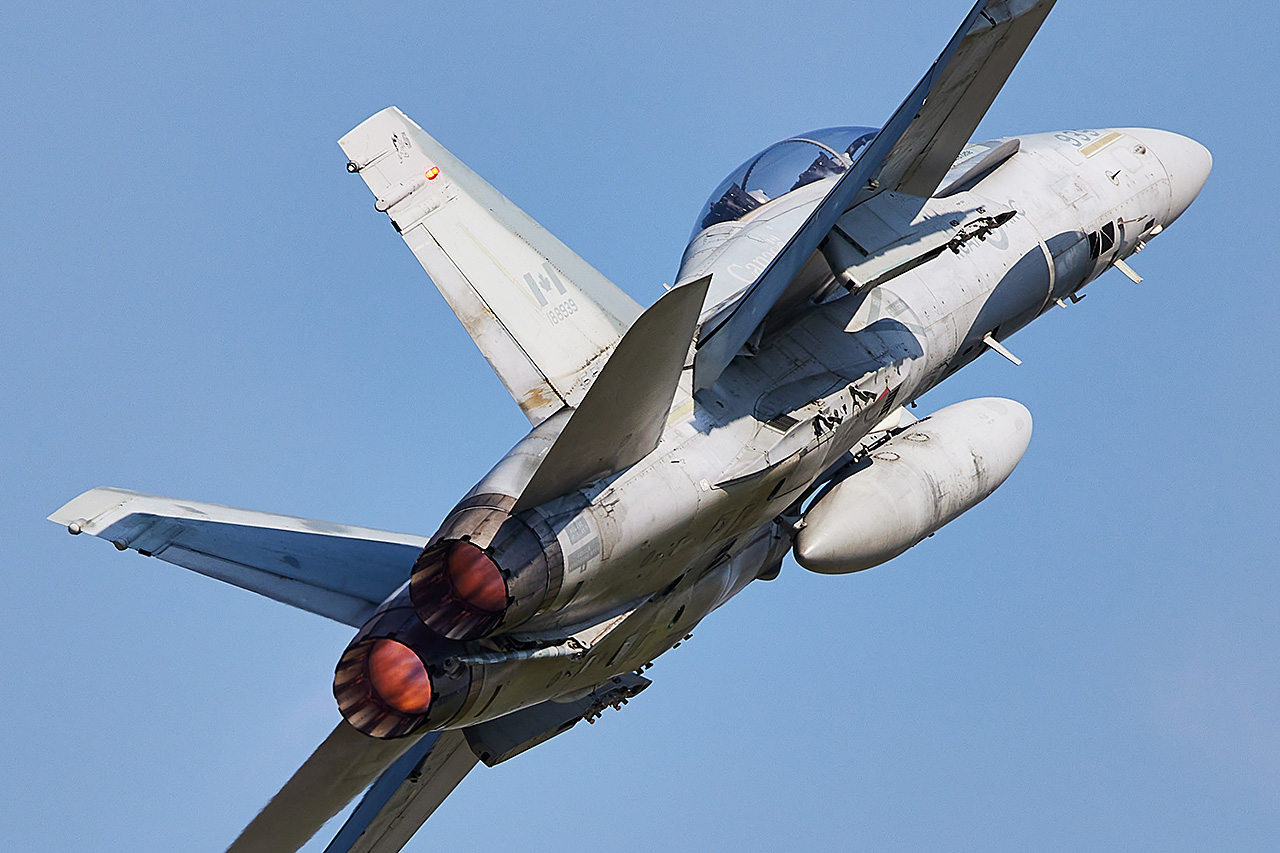
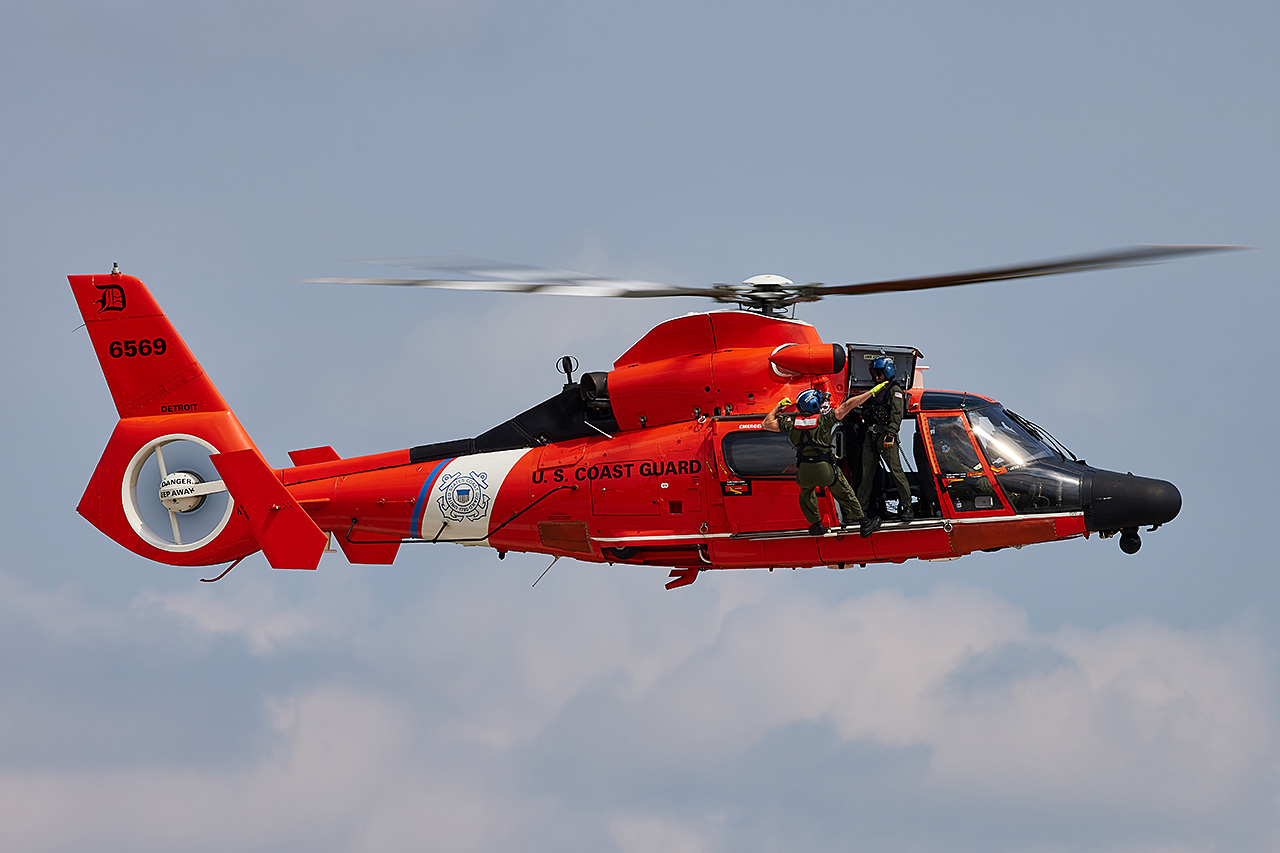
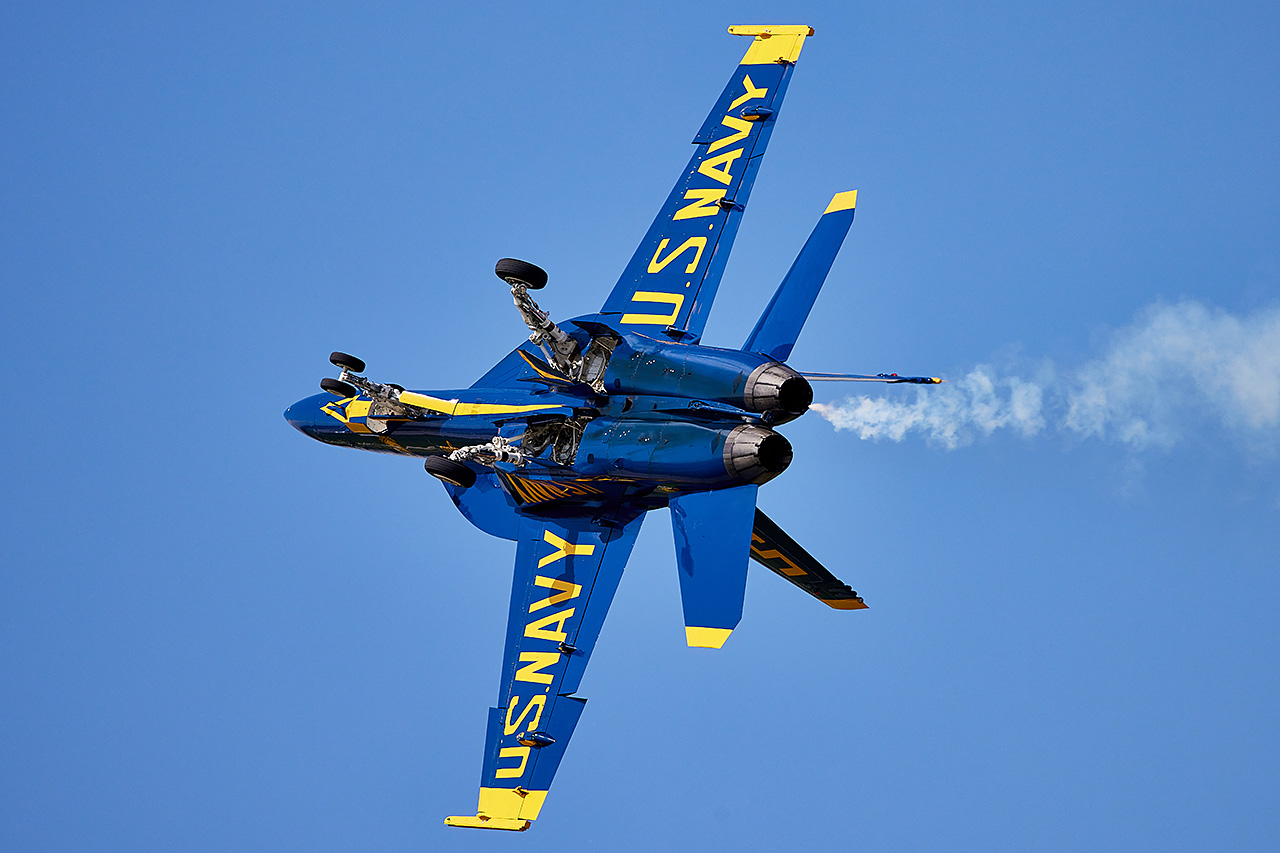
From August 27-29, 2021, Airshow London once again presented SkyDrive, Canada’s original socially distant drive-in style air show, at the London International Airport (CYXU) in Ontario, Canada. Organizers overcame some colossal challenges in 2020, and thanks to some serious muscle flexed by the United States Air Force (USAF) the event was named the best air show in North America in a Readers’ Choice Award Contest conducted by USA Today. In 2021, the USAF played a minor role, which was carried thanks to displays from the United States Navy (USN), Royal Canadian Air Force (RCAF) and United States Coast Guard (USCG). Regardless of who is booked to perform, London always provides visitors with one of the best sight lines available at any air show and a sun angle that is ever-improving throughout the day.
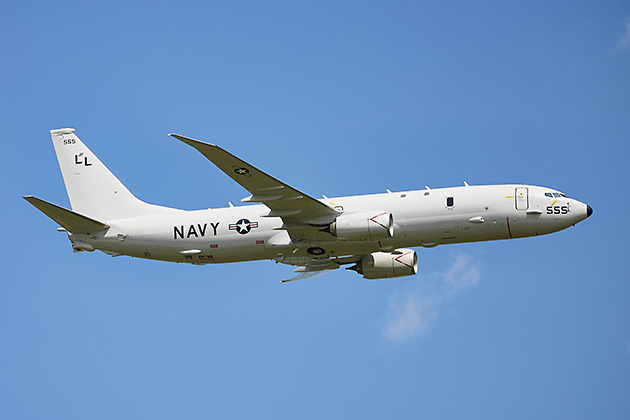
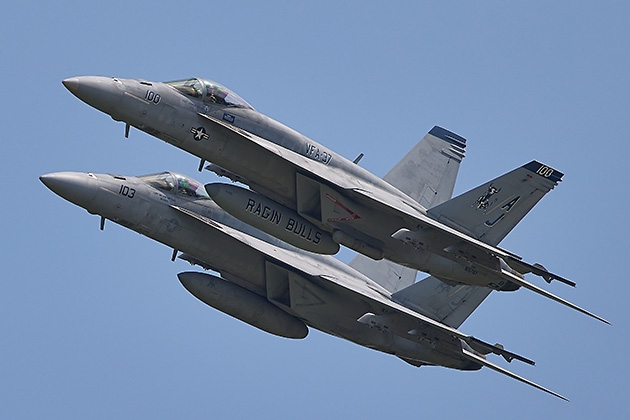
There was no static display again in 2021, but a welcome change was the authorization to base flying aircraft in London as opposed to having them operate from US locations as they had done the previous year. The lineup of aircraft looking south down Golf Taxiway from the spectators viewing areas was impressive, starting with the Navy’s newest maritime patrol aircraft, the Boeing P-8A POSEIDON. Next was a Lockheed Martin CC-130J HERCULES from the RCAF and a pair of examples from the USCG: a Eurocopter MH-65D DOLPHIN and an EADS HC-144A OCEAN SENTRY. Continuing south was an impressive group of fighters that included two USN Boeing F/A-18E SUPER HORNETS from the VFA-37 Ragin’ Bulls and four McDonnell Douglas CF-188A/B HORNETS from the RCAF. One of the Canadian Hornets was the CF-18 Demo Jet wearing the subdued “Strong at Home” livery. This aircraft was painted to symbolize the RCAF’s commitment to domestic operations and featured an Eagle on the tail that represented vigilance, agility, readiness and speed. There were also multiple tributes to the 431 Air Demonstration Squadron Snowbirds, including a full-size signature Snowbird SPEEDBIRD on the underside of the jet. Unfortunately, the display Hornet suffered a mechanical issue on arrival into London and was unable to fly during the show.
The Blue Angels were making their debut appearance in Canada with all new aircraft
S. Clish
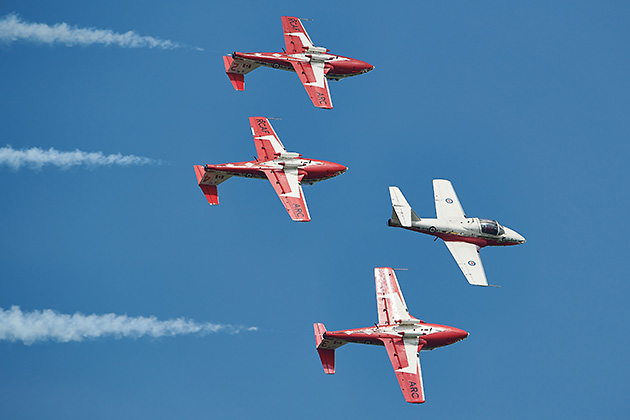
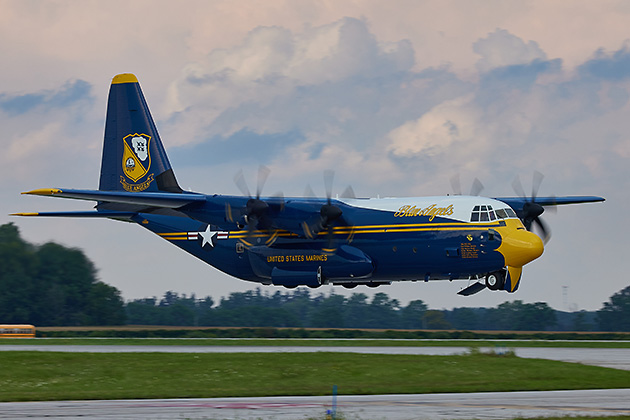
2020 was supposed to be a year of celebration for the Snowbirds, but a tragic accident on May 17 ended their 50th season before it truly began. Canada’s iconic air demonstration team was back to work in 2021 and celebrated their golden anniversary by applying a gold stripe along the side of each jet. As Canada’s ambassadors in the air, they represent the extraordinary skill and dedication of the Canadian Armed Forces while inspiring future generations of aviators. The Snowbirds eleven white and red Canadair CT-114 TUTORS, including nine display aircraft and two spares, were parked in the middle of a hornet’s nest with the six grey fighters to their left and the world renowned United States Navy Flight Demonstration Squadron Blue Angles on their right. The Blue Angels were making their debut appearance in Canada with all new aircraft: seven F/A-18E/F SUPER HORNETS and of course their special United States Marine C-130J support aircraft “Fat Albert”.
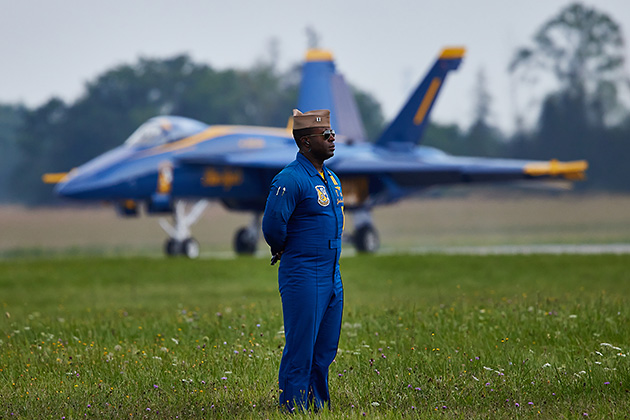
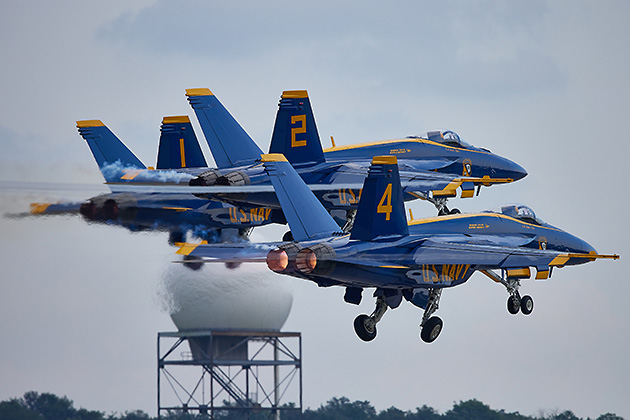
Even though the area where these aircraft were parked was not open to the public, having all of the performers located in London for the weekend added a wonderful dimension that was missing in 2020. Another element that was absent in 2020 was the “Hour of Power”. This wonderful Friday evening event can be especially rewarding for photography when the weather cooperates, but that hadn’t happened since 2017. The show was supposed to start around 1700 and was not to include the Blue Angels as participants, but their mid-afternoon practise session combined with an early opening of the gates allowed the team to be unofficially included in the extended “Hour of Power”. The weather however, did not initially cooperate. The Blues flew in some very challenging weather, and as nice as it was to see “Fat Albert” and the rest of the team perform, the conditions deteriorated enough that my father and I actually left during their display and were uncertain about the remainder of the evening. A quick trip to Anderson Craft Ales award-winning brewery and our conveniently located hotel allowed us to wait out the storm in comfort while maintaining the option of a quick return to the show.
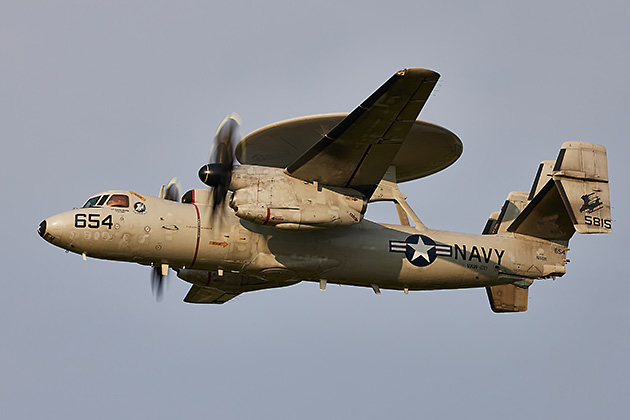
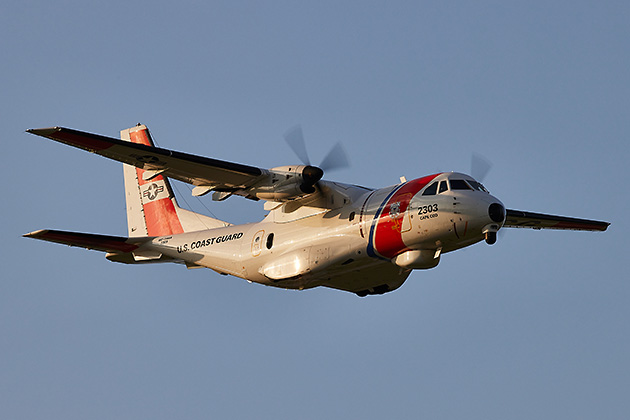
Just after 1800, the skies cleared and created the dynamic lighting conditions that photographers dream of. I returned for the end of the Snowbirds performance and got some lovely images of the jets landing with the golden fuselage stripe sparkling in the evening light. The aircraft that followed was a USN Grumman E-2C HAWKEYE from Carrier Airborne Early Warning Squadron 120 (VAW-120), the only performer that had to stage from the United States. The E-2 is a rare participant in most air show flying programmes, so I guess it’s not surprising how many spectators were awed by the maneuverability of the medium-sized twin-turboprop aircraft, especially with the large 24-foot (7.3 m) diameter rotating radar dome that is mounted on its fuselage. The Hawkeye performed multiple high-speed passes and steep banking turns in perfect conditions and won the admiration of the entire audience. The poor HC-144 that followed could not match the energy of the E-2 and appeared slow as it flew around the airport between passes. Still, the white, blue and red aircraft shone beautifully as it reflected the setting sun.
This unit traces its heritage back to 1944 when it was assigned to the China-Burma-India theatre of operations
Shawn Clish
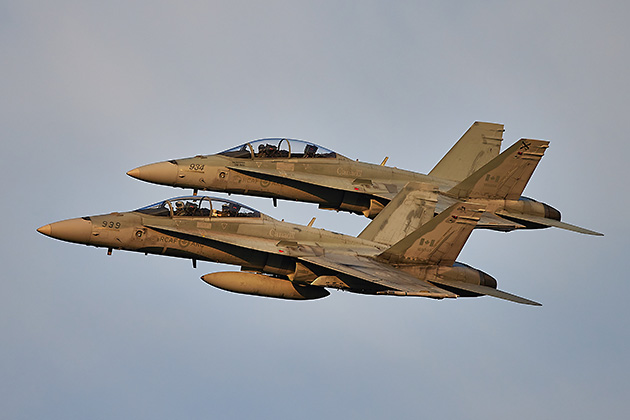
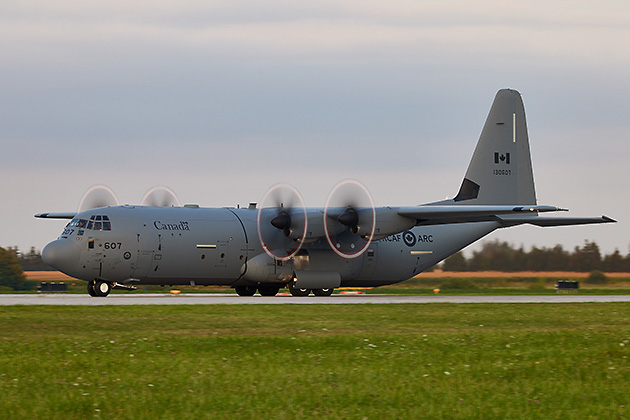
Three of the final four acts came from the RCAF. First up was a pair of CF-188B Hornets from 3 Wing Bagotville. Their routine started with a lovely formation pass and was followed by multiple passes in burner as the two jets beat up the airspace. As nice as the official demonstrations can be, sometimes they can seem too formal, so it was a pleasure to watch the pilots have fun while throwing their aircraft around the sky in maneuvers as basic as an early crosswind turn. They were followed by a CC-130J Hercules from 436 Transport Squadron out of Canadian Forces Base Trenton. This unit traces its heritage back to 1944 when it was assigned to the China-Burma-India theatre of operations. The squadron would go on to distinguish itself, flying more than six million miles under the adopted emblem, “Canucks Unlimited”.
With the sun set, it was time for the twilight display from CF-18 Demo pilot, Captain Dan Deluce
Shawn Clish
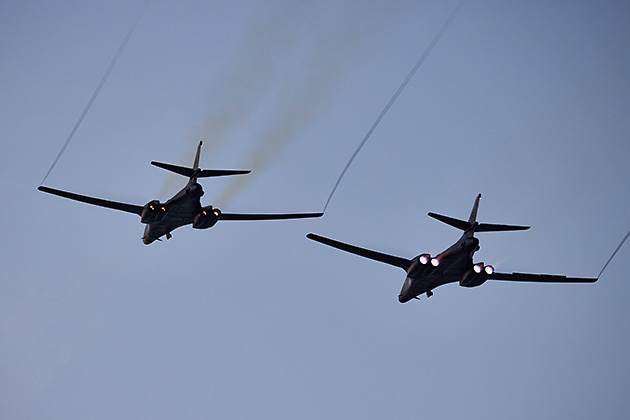
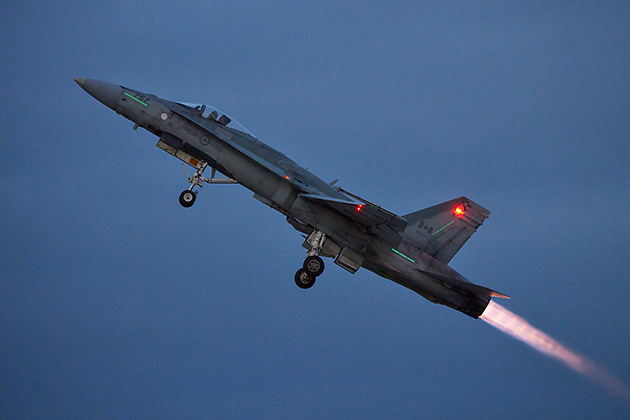
The most anticipated aircraft of the night were the pair of Rockwell B-1B LANCERS belonging to the 28th Bomb Wing located at Ellsworth Air Force Base, South Dakota. There was plenty of optimism about what this formation could do with their General Electric F101-GE-102 afterburning turbofan engines, but unfortunately they only made one pass and didn’t apply the burners until well north of the airport. Still, it was impressive to see these wonderful bombers pass overhead, the only aircraft from the USAF to fly in the Friday show.
With the sun set, it was time for the twilight display from CF-18 Demo pilot, Captain Dan Deluce. Camera ISO settings were adjusted to uncomfortably high levels to capture as much light as possible, while steady hands were needed for sharp images at reduced shutter speeds. The takeoff and display were impressive and the performance was capped off with a tail hook down landing that sent sparks flying as it dragged along Runway 15.
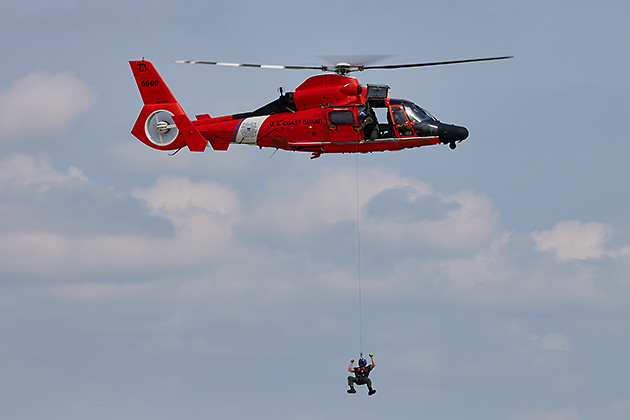
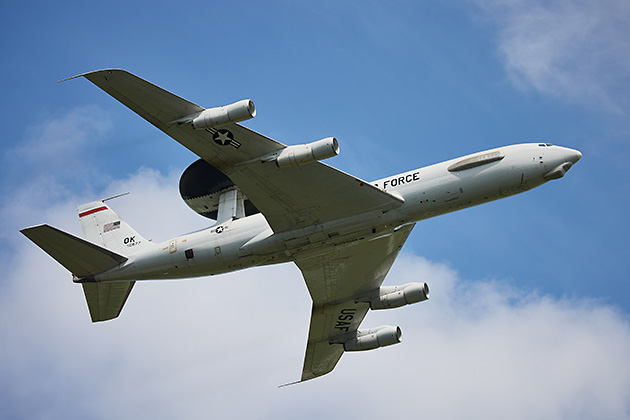
I enjoyed a later start on the morning of Saturday August 28 than I would have had there been a static display. The morning weather was clear and blue and stayed that way for most of the show. The performers were very similar to Friday evening, and once again the E-2C and the pair of CF-188s were very impressive. The MH-65 performed a simulated search and rescue display at show centre and the technician that was lowered took full opportunity of his time in the spotlight, flexing his muscles in the air and doing push-ups once on the ground. His enthusiastic spirit was a pleasure to watch and it allowed for a lighter moment during a routine that represents a serious race to save lives when called to action. The USAF made their daily appearance, this time in the form of a Boeing E-3B SENTRY, which made two passes overhead. The Snowbirds displayed some impressive adaptability as they started with a high-show but due to the encroaching clouds, transitioned during their performance to a low-show. Even with 60 year old aircraft it is always inspiring to watch the professionalism of this team. Ahead of the Blue Angels performance, a large storm started to develop southwest of the airport. There were plenty of nervous moments as the air boss and safety personnel used every meteorological prediction method available to make sure that it would be safe for the team to fly. And while it was great that the storm remained a safe distance away, it happened to stall directly between the sun and the show, obscuring the light that should have been on “Fat Albert” and the six “Blue Angel” blue and “Insignia” yellow Super Hornets. Photography complaints aside, it was incredible to watch the Blue Angels, especially from the close proximity that the layout at London provides. I don’t know if any other aviation event seats the crowd closer to the runway than at London, so the “Fat Albert” low transition, the “Diamond Burner Go” formation take off and the solos dirty roll and low transition departures look even more impressive. I have always been enthralled by the Blue Angels, believing them to have the highest level of skill and professionalism of any demonstration team in the world. Their upgrade to the Super Hornet, with 35% more thrust than the legacy model, only enhanced what was already a world class display.
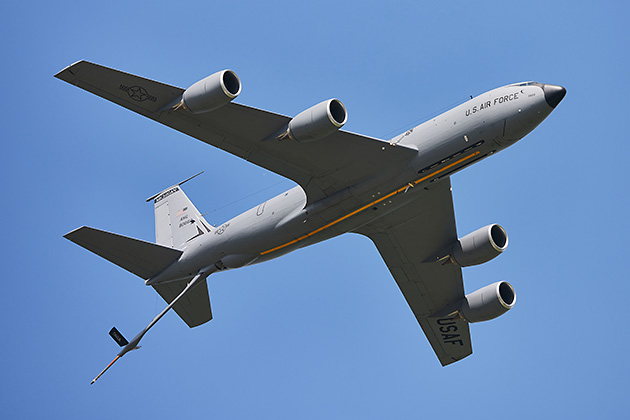
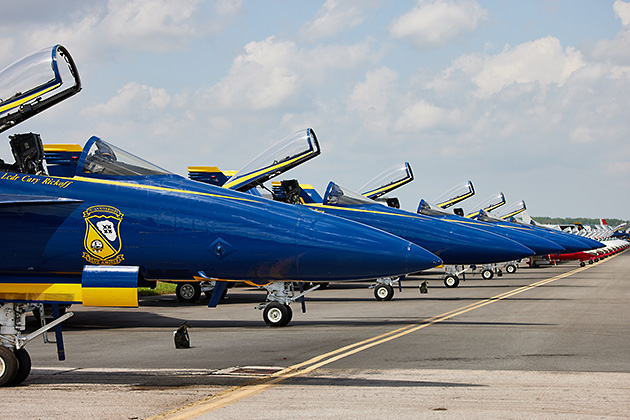
Sunday provided a special opportunity to access the hot ramp. It was a pleasure to be able to photograph the performing aircraft ahead of their displays as the hard working yet under recognized ground crews performed their necessary work. It was an interesting vantage point that offered a different angle than I had been enjoying at show centre the previous two days and lead to some fun pictures of the aircraft taxiing to and from their parking locations. Sunday saw the USN play a bigger role in the show, as the P-8A and the F/A-18Es performed before heading home to their respective bases. The daily visitor from the USAF was a Boeing KC-135T STRATOTANKER from the 127th Wing at nearby Selfridge Air National Guard Base, Michigan. As enjoyable as the special location was. I still had yet to capture the Blue Angels under ideal conditions and hoped the weather would continue to offer blue skies for their performance. I returned to a more traditional location, among the photographers in the photo pit, and was excited when the Navy’s best took to their jets in their 75th anniversary yellow flight suits under a cloudless sky. Their routine on Sunday afternoon, to close out a very enjoyable Airshow London, was the highlight of the weekend.
Airshow London has always been one of the best air shows in North America, so it was wonderful for them to get the recognition I believe they’ve rightfully earned. Their combination of aircraft, crowd location and sun angle are a dream for aviation photography but there is also a friendly atmosphere created by the hard working organizers and volunteers that must be acknowledged. I have been coming to events in London since 1983 and even though my opinion is biased, I still feel comfortable telling anyone that will listen about this must-attend event. See you September 9-11, 2022!
A huge thank you to Mike Lewis, Gerry Vanderhoek, Tori-Lyn Hill and Diana Spremo for all of their help and support this year.
Shawn Clish / CHK6

